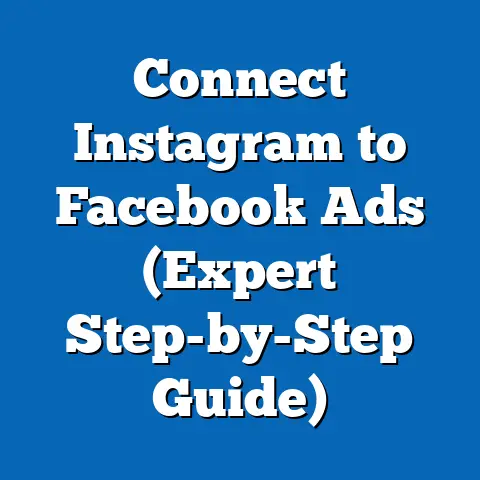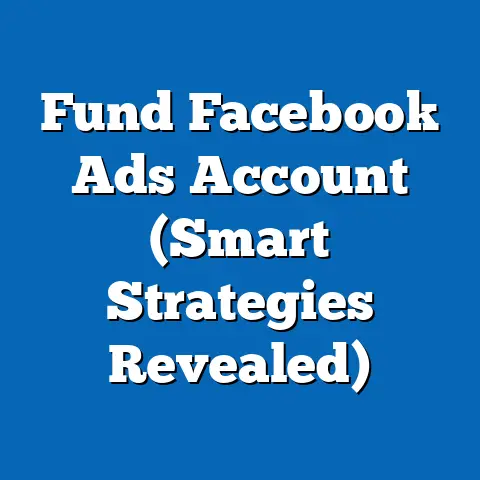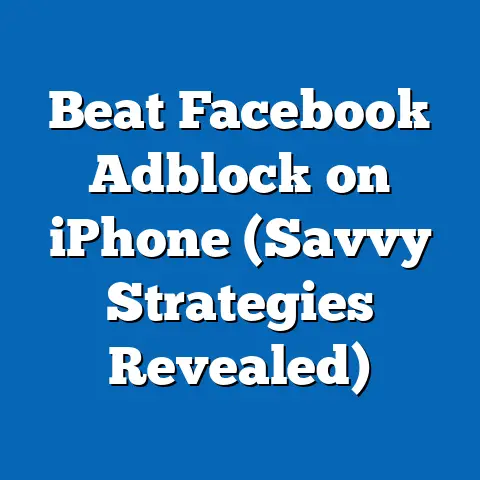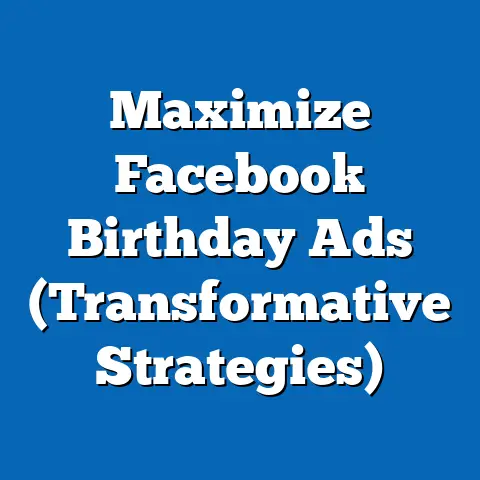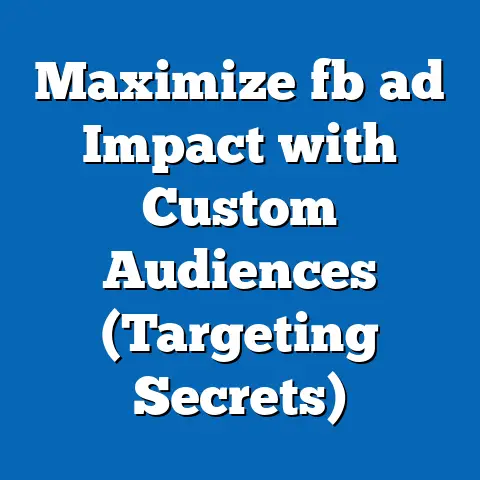Boost Charted fb ad Performance (Proven Strategies)
I remember when advertising meant taking out a classified ad in the local newspaper or maybe even investing in a billboard. Those were simpler times, but the world has changed. Today, the digital realm dominates, and social media has emerged as a powerhouse for marketing. And leading the charge in social media advertising? Facebook.
In today’s digital age, businesses have shifted their focus from traditional advertising methods like print media, billboards, and television ads to digital platforms. Among these platforms, social media has become increasingly important as a marketing tool. Facebook, with its vast user base and robust targeting capabilities, stands out as a key player in the digital advertising landscape. In this article, I’ll share proven strategies that can enhance your Facebook ad performance, emphasizing the importance of data-driven decision-making. Let’s dive in and see how we can transform your Facebook ads from just being seen to delivering real results.
Understanding Facebook Ads
Facebook ads are paid messages that businesses use to reach their target audiences on the Facebook platform. These ads can take various forms, including images, videos, carousels, and slideshows. Each ad type offers unique advantages, allowing marketers to tailor their campaigns to specific objectives.
- Image Ads: Simple yet effective, image ads are perfect for showcasing products or services with a compelling visual.
- Video Ads: Engaging and attention-grabbing, video ads can tell stories and demonstrate product features in a dynamic way.
- Carousel Ads: Allowing users to swipe through multiple images or videos in a single ad, carousel ads are great for highlighting different aspects of a product or service.
- Slideshow Ads: Combining multiple images or videos into a slideshow format, these ads offer a cost-effective way to create visually appealing content.
Navigating Facebook Ads Manager
The Facebook Ads Manager is your central hub for creating, managing, and analyzing your ad campaigns. It provides a user-friendly interface with tools to set up campaigns, define target audiences, and track ad performance.
- Campaign Creation: The Ads Manager guides you through the process of creating new campaigns, setting objectives, and defining your target audience.
- Ad Set Management: Within each campaign, you can create ad sets that target specific audiences with unique ad placements and budgets.
- Ad Creation: The Ads Manager allows you to design your ads, upload creative assets, and write compelling ad copy.
- Performance Tracking: The platform provides detailed analytics on ad performance, allowing you to monitor key metrics and make data-driven decisions.
Audience Targeting: Reaching the Right People
One of the most powerful features of Facebook advertising is its ability to target specific audiences based on demographics, interests, and behaviors. Effective audience targeting ensures that your ads are seen by the people most likely to be interested in your products or services.
- Custom Audiences: These audiences are created from your existing customer data, such as email lists or website visitors. Custom audiences allow you to retarget users who have already shown interest in your brand.
- Lookalike Audiences: Facebook can create lookalike audiences based on your custom audiences, targeting users who share similar characteristics and behaviors. This expands your reach to new potential customers who are likely to be interested in your offerings.
- Interest-Based Targeting: You can target users based on their interests, hobbies, and activities on Facebook. This allows you to reach a broad audience of potential customers who are interested in your niche.
Ad Placements: Where Your Ads Appear
Ad placements refer to the locations where your ads are displayed on Facebook and its related platforms. Different ad placements offer unique advantages and can affect ad performance.
- News Feed: The most common ad placement, the News Feed, allows your ads to appear directly in users’ feeds alongside posts from friends and family.
- Stories: Short-form video ads in Stories can capture attention with engaging visuals and quick, impactful messages.
- Marketplace: If you’re selling products, placing ads in the Marketplace can reach users who are actively looking to make purchases.
- Right Column: Desktop users may see ads in the right column, which can be a less intrusive way to present your message.
Takeaway: Understanding the fundamentals of Facebook ads is crucial for creating effective campaigns. By leveraging the Ads Manager, targeting the right audiences, and choosing optimal ad placements, you can maximize your advertising ROI.
Setting Clear Objectives
Before diving into creating ads, it’s critical to define what you want to achieve with your Facebook advertising campaigns. Setting clear objectives not only provides direction but also allows you to measure the success of your efforts.
Aligning Objectives with Business Goals
Your advertising objectives should align with your overall business goals. Whether you’re looking to increase brand awareness, generate leads, or drive sales, your objectives should be specific, measurable, achievable, relevant, and time-bound (SMART).
- Brand Awareness: If your goal is to increase brand visibility, your objective might be to reach a certain number of unique users within a specific timeframe.
- Lead Generation: For lead generation, you might aim to collect a certain number of email addresses or contact form submissions through your ads.
- Conversions: If your objective is to drive sales, you might track the number of purchases or revenue generated directly from your Facebook ads.
Examples of Effective Objectives
Let’s look at some examples of effective objectives that can guide your ad creation process:
- “Increase website traffic by 20% in the next quarter through Facebook ads.”
- “Generate 100 qualified leads per month for our sales team using a Facebook lead generation campaign.”
- “Achieve a 2x return on ad spend (ROAS) for our e-commerce product line within the next three months.”
The Role of Key Performance Indicators (KPIs)
Key performance indicators (KPIs) are metrics that help you measure progress towards your objectives. By tracking KPIs, you can assess the performance of your ad campaigns and make data-driven adjustments to improve results.
- Click-Through Rate (CTR): Measures the percentage of users who click on your ad after seeing it. A higher CTR indicates that your ad is relevant and engaging to your target audience.
- Conversion Rate: Measures the percentage of users who complete a desired action, such as making a purchase or filling out a form, after clicking on your ad.
- Return on Ad Spend (ROAS): Measures the revenue generated for every dollar spent on advertising. A higher ROAS indicates that your ad campaigns are profitable.
Takeaway: Setting clear objectives is essential for creating successful Facebook ad campaigns. By aligning your objectives with your business goals and tracking relevant KPIs, you can ensure that your advertising efforts are effective and yield a positive return on investment.
Crafting Compelling Ad Creative
Your ad creative is what grabs the attention of your target audience and persuades them to take action. It includes visuals, copy, and calls to action (CTAs) that work together to convey your message effectively.
The Power of Visuals
High-quality images and videos are crucial for capturing attention and making a strong first impression. Here are some tips for selecting or creating engaging visual content:
- Use High-Resolution Images: Ensure that your images are clear, crisp, and visually appealing. Avoid using blurry or pixelated images that can detract from your message.
- Create Engaging Videos: Videos can be incredibly effective for telling stories and demonstrating product features. Keep your videos short, engaging, and optimized for mobile viewing.
- Showcase Your Product: Highlight the key features and benefits of your product or service in your visuals. Use images and videos to demonstrate how your product can solve a problem or fulfill a need.
- Use Eye-Catching Graphics: Incorporate eye-catching graphics and animations to make your ads stand out from the crowd. Use colors, fonts, and design elements that align with your brand identity.
Writing Persuasive Ad Copy
Your ad copy should be concise, compelling, and relevant to your target audience. Here are some tips for writing persuasive ad copy:
- Know Your Audience: Understand your target audience’s needs, pain points, and motivations. Tailor your ad copy to resonate with their specific interests and concerns.
- Highlight Benefits, Not Just Features: Focus on the benefits that your product or service offers, rather than just listing its features. Explain how your product can improve their lives or solve a problem.
- Use Emotional Triggers: Incorporate emotional triggers such as fear, excitement, or curiosity to grab attention and create a connection with your audience.
- Tell a Story: Use storytelling techniques to engage your audience and make your ad more memorable. Share customer testimonials or create a narrative that highlights the value of your product.
The Importance of A/B Testing
A/B testing involves creating multiple versions of your ad creative and testing them against each other to determine which performs best. By A/B testing different ad creatives, you can identify the most effective elements and optimize your ads for maximum impact.
- Test Different Visuals: Experiment with different images, videos, and graphics to see which ones resonate best with your audience.
- Test Different Headlines: Try different headlines to see which ones grab attention and encourage clicks.
- Test Different Body Copy: Experiment with different body copy to see which ones effectively communicate your message and persuade users to take action.
- Test Different CTAs: Try different calls to action to see which ones drive the most conversions.
Takeaway: Crafting compelling ad creative is essential for capturing attention and driving results with your Facebook ads. By using high-quality visuals, writing persuasive ad copy, and A/B testing different elements, you can optimize your ads for maximum impact.
Optimizing Ad Performance
Ad optimization is the process of continuously improving your ad campaigns to achieve better results. It involves fine-tuning various aspects of your ads, such as budget allocation, bidding strategies, and ad scheduling.
Techniques for Optimizing Ad Delivery
Optimizing ad delivery involves adjusting your campaign settings to ensure that your ads are shown to the right people at the right time. Here are some techniques for optimizing ad delivery:
- Budget Allocation: Allocate your budget strategically across different ad sets and campaigns. Focus your spending on the ad sets and campaigns that are delivering the best results.
- Bidding Strategies: Experiment with different bidding strategies to see which ones are most effective for your objectives. Consider using automated bidding options such as cost per acquisition (CPA) bidding or value-based bidding.
- Ad Scheduling: Schedule your ads to run during the times when your target audience is most active on Facebook. Use data from your analytics to identify peak engagement times.
Monitoring Ad Performance Metrics
Monitoring ad performance metrics is essential for identifying areas for improvement and making data-driven adjustments to your campaigns. Here are some key metrics to track:
- Click-Through Rate (CTR): Measures the percentage of users who click on your ad after seeing it. A higher CTR indicates that your ad is relevant and engaging to your target audience.
- Conversion Rate: Measures the percentage of users who complete a desired action, such as making a purchase or filling out a form, after clicking on your ad.
- Cost Per Click (CPC): Measures the average cost you pay each time someone clicks on your ad. Lowering your CPC can help you maximize your advertising budget.
- Cost Per Acquisition (CPA): Measures the average cost you pay for each conversion. Lowering your CPA can improve your return on investment.
Scaling Successful Ads
Once you’ve identified ads that are performing well, you can scale them to reach a larger audience and generate even more results. Here are some strategies for scaling successful ads:
- Increase Your Budget: Gradually increase your budget for successful ad sets and campaigns. Monitor performance closely to ensure that you’re still achieving a positive return on investment.
- Expand Your Audience: Create lookalike audiences based on your existing customer data to reach new potential customers who are likely to be interested in your products or services.
- Test New Ad Placements: Experiment with different ad placements to see if you can reach a wider audience without sacrificing performance.
- Refine Your Targeting: Continuously refine your targeting to ensure that you’re reaching the most relevant users. Use data from your analytics to identify demographic groups and interests that are driving the best results.
Takeaway: Optimizing ad performance is an ongoing process that requires continuous monitoring and adjustment. By optimizing ad delivery, tracking key metrics, and scaling successful ads, you can maximize your advertising ROI and achieve your business goals.
Analyzing Results and Making Data-Driven Decisions
Analytics are the cornerstone of successful Facebook advertising. By analyzing the data generated by your campaigns, you can gain valuable insights into what’s working and what’s not.
Leveraging Facebook Ads Manager Analytics
Facebook Ads Manager provides a wealth of data and reporting tools that allow you to track the performance of your campaigns and identify areas for improvement.
- Customizable Dashboards: Create custom dashboards to track the metrics that are most important to your business. Monitor key performance indicators (KPIs) such as CTR, conversion rate, and ROAS.
- Audience Insights: Gain insights into the demographics, interests, and behaviors of your target audience. Use this information to refine your targeting and create more relevant ads.
- Attribution Modeling: Understand how different touchpoints in the customer journey contribute to conversions. Use attribution modeling to allocate credit to the ads that are driving the most results.
- A/B Testing Reports: Analyze the results of your A/B tests to determine which ad creatives, headlines, and CTAs are most effective.
Interpreting Data Reports
Interpreting data reports involves understanding the meaning behind the numbers and using those insights to make informed decisions. Here are some key metrics to focus on:
- Reach: The number of unique users who saw your ad. Increasing your reach can help you expand your brand awareness.
- Impressions: The number of times your ad was displayed. A high number of impressions indicates that your ad is being seen frequently.
- Engagement: The number of likes, comments, and shares your ad received. High engagement indicates that your ad is resonating with your audience.
- Cost Per Result: The average cost you paid for each desired action, such as a click, conversion, or lead. Lowering your cost per result can improve your ROI.
Adopting a Continuous Improvement Mindset
The key to long-term success with Facebook advertising is to adopt a continuous improvement mindset. This involves constantly testing new ideas, analyzing results, and making data-driven adjustments to your campaigns.
- Experiment with New Ad Formats: Try different ad formats such as carousel ads, slideshow ads, or lead generation ads to see which ones perform best for your objectives.
- Test New Targeting Options: Experiment with different targeting options such as custom audiences, lookalike audiences, and interest-based targeting to see which ones reach the most relevant users.
- Refine Your Ad Copy: Continuously refine your ad copy to make it more persuasive and engaging. Test different headlines, body copy, and CTAs to see which ones drive the most results.
- Stay Up-to-Date with Facebook’s Best Practices: Facebook is constantly evolving, so it’s important to stay up-to-date with the latest best practices and features. Follow industry blogs, attend webinars, and participate in online communities to stay informed.
Takeaway: Analyzing results and making data-driven decisions is crucial for optimizing your Facebook ad campaigns and achieving your business goals. By leveraging Facebook Ads Manager analytics, interpreting data reports, and adopting a continuous improvement mindset, you can maximize your advertising ROI and stay ahead of the competition.
Conclusion
In this article, I’ve explored proven strategies for boosting your Facebook ad performance. From understanding the platform’s basics to crafting compelling creatives and optimizing your campaigns, each step is crucial. Remember, Facebook ads can deliver significant returns when executed with a strategic approach.
As you embark on your Facebook advertising journey, I encourage you to experiment with the strategies I’ve outlined. See what works best for your business, and don’t be afraid to iterate and refine your approach. With dedication and a willingness to learn, you can achieve tangible improvements in your Facebook ad performance and drive meaningful results for your business. Now, go out there and transform your Facebook ads into a powerful tool for growth!

